The Best and Worst Environments for German Shepherds
Are you considering bringing a German Shepherd into your family, or are you a current owner wondering if your home is suitable for your loyal companion? German Shepherds are known for their intelligence, loyalty, and versatility, making them one of America’s most popular breeds.
However, their wellbeing is significantly impacted by their living environment. These active dogs require a living situation that meets their specific needs to remain healthy and happy.
Not all homes are created equal when it comes to dogs like German Shepherds. Some environments allow them to thrive, while others may lead to behavioral issues or health problems.
Key Takeaways
- Understanding the specific needs of German Shepherds is crucial for their wellbeing.
- The living environment plays a significant role in the health and happiness of your dog.
- Factors such as physical space, climate, and family dynamics impact your German Shepherd’s quality of life.
- A suitable environment can prevent behavioral issues and health problems.
- Assessing your home’s suitability is essential for providing the best life for your German Shepherd.
Understanding German Shepherd Characteristics
Understanding the characteristics of German Shepherds is crucial for providing them with a suitable environment. As a breed known for their loyalty and intelligence, they require specific care and attention to thrive.
Physical Traits and Size
German Shepherds are a medium to large-sized dog breed, known for their muscular build and agile physique. They typically stand between 24 and 26 inches tall at the shoulder and weigh between 75 and 95 pounds.
Temperament and Intelligence
The German Shepherd is highly regarded for its exceptional intelligence and loyalty. They are highly trainable, which makes them excel in various roles, from family pets to service dogs. Their high intelligence means they require regular mental stimulation and training to prevent boredom.
Some key characteristics of the breed include their loyal and protective nature, making them excellent watchdogs. They form strong bonds with their families and are generally wary of strangers, highlighting the importance of proper socialization. Their strong work ethic and purpose-driven mindset mean they thrive in environments where they have jobs or responsibilities.
Exercise Requirements for German Shepherds
German Shepherds are a dynamic breed that thrives on activity, necessitating a regimen that includes both physical and mental stimulation. As a high-energy dog, they require regular exercise to stay happy and healthy.
Daily Physical Activity Needs
Your German Shepherd needs daily physical activity to maintain their physical health and satisfy their instinct to work. This can include activities like running, hiking, or agility training. A minimum of 30 minutes of exercise per day is recommended, but more energetic dogs may require up to 1-2 hours of activity.
- Regular walks and playtime are essential for maintaining their physical health.
- Engaging in activities that challenge them physically, such as fetch or agility training, can help burn off excess energy.
Mental Stimulation Requirements
In addition to physical exercise, German Shepherds require mental stimulation to prevent boredom and destructive behaviors. Activities that challenge their intelligence, such as puzzle toys or scent work, are highly beneficial. Providing your dog with problem-solving tasks and training sessions can help keep their mind engaged and active.
- Training sessions that focus on obedience or agility can provide mental stimulation.
- Rotating toys and introducing new challenges can help prevent cognitive stagnation.
The Best and Worst Environments for German Shepherds
The environment you provide for your German Shepherd significantly impacts their well-being and behavior. As a highly social and energetic breed, they require a living situation that caters to their physical and emotional needs.
Ideal Living Spaces
German Shepherds thrive in homes with secure outdoor spaces where they can exercise and play. A house with a yard is ideal, as it provides them with the freedom to move around and expend their energy. If you live in a home without a yard, you’re committed to providing regular exercise and mental stimulation through other means.
Some key factors to consider in ideal living spaces include:
- Access to regular exercise areas
- A secure outdoor space to prevent escape or injury
- A living situation that allows for frequent interaction and training
Challenging Living Situations
Certain living situations can be challenging for German Shepherds. For example:
- Small apartments without nearby exercise areas can lead to destructive behaviors and anxiety.
- Environments with extreme heat can be dangerous due to their thick double coats, potentially causing heat stroke.
- Living situations where the dog is left alone for extended periods regularly can lead to separation anxiety and behavioral issues.

By understanding the needs of your German Shepherd, you can create a living situation that supports their well-being and helps them thrive.
German Shepherds in Houses with Yards

Having a yard is beneficial for German Shepherds as it caters to their physical and mental health needs. A yard provides them with the space to run, play, and exercise, which is essential for their overall well-being.
Benefits of Yard Access
Access to a yard offers numerous benefits for German Shepherds. It allows them to engage in physical activities, such as running and playing fetch, which helps maintain their physical health. Moreover, a yard provides mental stimulation by exposing them to various sights, smells, and sounds.
Key benefits include:
- Secure fencing at least 6 feet tall is essential for German Shepherds, as they are athletic jumpers and determined diggers who may escape if motivated.
- Make sure your yard is free from toxic plants, chemicals, and small objects that could be ingested by curious German Shepherds during their exploration.
- Provide shaded areas and fresh water access throughout your yard to prevent overheating during warmer months when your German Shepherd is outside.
- Regularly inspect your yard for potential escape routes, including gaps in fencing, loose boards, or areas where digging could lead to freedom.
- Consider your neighbors when planning yard time, as German Shepherds can be vocal and their barking might create tension in densely populated neighborhoods.
Yard Safety Considerations
While a yard is beneficial, it’s crucial to ensure it’s safe for your German Shepherd. This involves checking for and removing any hazardous materials, securing the fencing to prevent escape, and providing adequate shade and water.
By taking these precautions, you can create a safe and enjoyable outdoor space for your dog, enhancing their quality of life and strengthening your bond with them.
Can German Shepherds Thrive in Apartments?
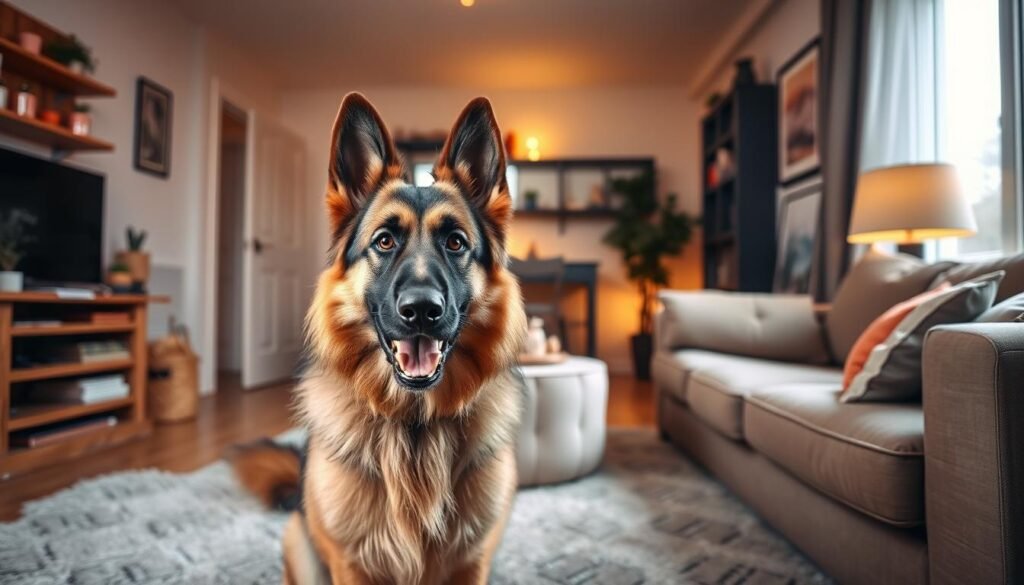
You can successfully raise a German Shepherd in an apartment by understanding their specific needs. While they are often associated with spacious homes, German Shepherds can adapt to apartment living with proper care and attention.
Apartment Living Challenges
Living in an apartment with a dog like a German Shepherd presents several challenges, including limited space for exercise and potential noise issues. Shepherds are active dogs that require regular physical activity to stay healthy and happy.
Making Apartment Living Work
To make apartment living work for your German Shepherd, several strategies can be employed.
– Successful apartment living with a German Shepherd requires a strict commitment to multiple daily walks and exercise sessions.
– Investing in training early and consistently helps manage potential noise issues.
– Make sure to choose a ground-floor apartment when possible to minimize noise transfer and provide easier access to outdoor areas.
– Creating designated play and rest areas within your apartment helps establish boundaries.
– Incorporating daily mental stimulation through puzzle toys and enrichment activities helps compensate for limited physical space.
By following these guidelines and being committed to your German Shepherd’s needs, you can create a happy and healthy environment for your dog even in an apartment setting.
Climate Considerations for German Shepherds
The climate in your area can significantly impact your German Shepherd’s well-being. German Shepherds have a double coat that plays a crucial role in their temperature regulation. This double coat consists of a soft, fluffy undercoat and a coarser outer coat.
Cold Weather Adaptability
German Shepherds are generally well-adapted to cold weather due to their double coat. The inner coat, or undercoat, is particularly effective at keeping them warm. This makes them suitable for living in colder climates, provided they have adequate shelter and care.
Hot Weather Challenges
In contrast, German Shepherds face significant challenges in hot climates. Their thick double coat can lead to overheating and heat stroke, especially in high temperatures. Dark-colored German Shepherds, such as those with black and tan coloring, are at an increased risk due to their coat absorbing more heat. To keep your German Shepherd safe in hot weather, it’s essential to limit their outdoor activities to cooler parts of the day, ensure they have access to shade and fresh water, and consider cooling options like kiddie pools. Never shave your German Shepherd’s double coat, as it disrupts their natural temperature regulation and can lead to sunburn.
German Shepherds in Families with Children
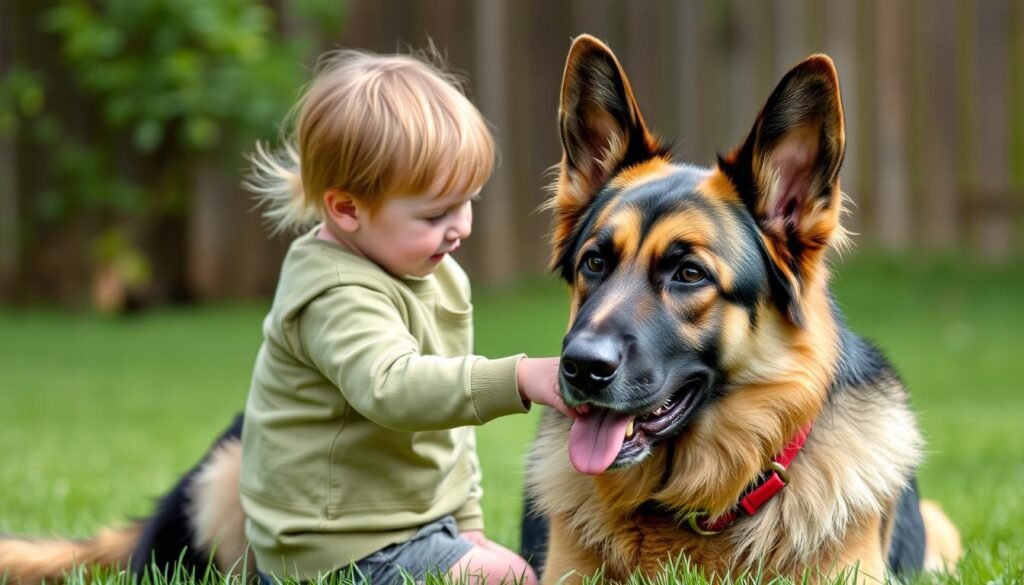
Understanding how German Shepherds interact with children is vital for a harmonious family environment. German Shepherds can be an excellent addition to families with kids if properly socialized and trained.
Benefits for Children
Having a German Shepherd can be highly beneficial for children. They can teach kids about responsibility, empathy, and compassion. Moreover, German Shepherds are often very loyal and protective of their family members, making them great companions.
The presence of a German Shepherd can also encourage children to engage in outdoor activities and play, promoting a healthier lifestyle.
Safety Guidelines and Supervision
While German Shepherds can be wonderful with children, it’s crucial to supervise their interactions, especially with toddlers or young children. Teaching children how to gently interact with the dog and respecting the dog’s personal space is essential.
Some key safety guidelines include always supervising interactions between German Shepherds and children, teaching children proper ways to approach and pet the dog, and creating safe zones where the dog can retreat when needed.
- Always supervise interactions between German Shepherds and children, especially with toddlers or young children who may not understand appropriate boundaries.
- Teach children proper ways to approach, pet, and play with your German Shepherd, emphasizing gentle handling and respect for the dog’s space and signals.
- Create safe zones where your German Shepherd can retreat when needing a break from children’s energy, ensuring the dog has an escape from overwhelming situations.
- Begin socialization between your German Shepherd puppy and children early, carefully monitoring and guiding positive interactions that build mutual respect.
- Establish clear rules for both children and the dog regarding acceptable play, handling of toys, and behavior during feeding times to prevent resource guarding issues.
German Shepherds in Multi-Pet Households

German Shepherds can thrive in multi-pet households if you understand their compatibility with other animals. Ensuring harmony among pets requires careful consideration and management.
Compatibility with Other Dogs
German Shepherds can get along well with other dogs, especially if they’re socialized from an early age. Proper introduction and training are key to maintaining a peaceful coexistence.
Interactions with Cats
Interactions between German Shepherds and cats can be challenging. While some German Shepherds can live harmoniously with cats, caution and supervision are necessary, especially during the initial stages.
Small Animals and Prey Drive Concerns
Due to their strong prey drive, German Shepherds are not safe for small animals like guinea pigs, hamsters, rabbits, or birds. Secure, separate living spaces are essential to prevent any harm. Key considerations include:
– German Shepherds possess a strong prey drive that makes cohabitation with small pets potentially dangerous.
– The quick, darting movements of small animals can trigger instinctual chasing behaviors.
– Never leave your German Shepherd unsupervised with small pets.
Work Environments and German Shepherds
Balancing your work life with the needs of your German Shepherd is essential for their overall well-being and your peace of mind. Your work environment significantly impacts your dog’s lifestyle.
Working From Home Benefits
Working from home can be highly beneficial for your German Shepherd, as it allows for more frequent interaction and the ability to monitor their needs. This setup can help reduce separation anxiety and destructive behaviors associated with being left alone.
Managing Long Work Hours
If you have a traditional 8+ hour workday away from home, consider the following strategies to manage your dog’s alone time:
- Create a structured routine with morning exercise to deplete energy and encourage restful behavior during your absence.
- Utilize midday dog walkers or pet sitters to provide your German Shepherd with necessary breaks.
- Engage your dog with enrichment toys, puzzle feeders, and rotating activities to create mental stimulation.
- Consider doggy daycare options several days a week if your work schedule consistently requires long hours away from home.
German Shepherds for Active vs. Sedentary Owners
Your activity level plays a significant role in determining whether a German Shepherd is the right fit for you. German Shepherds are a versatile breed that can adapt to various lifestyles, but they do require a certain level of care and attention. As an owner, understanding how your activity level impacts your dog’s well-being is crucial.
Ideal Activity Levels for Owners
German Shepherds are inherently active dogs that require regular exercise to stay healthy and happy. Ideally, owners should have an active lifestyle that includes daily walks, runs, or playtime. Active owners can provide their German Shepherds with the physical and mental stimulation they need, making them ideal companions for outdoor enthusiasts.
Making It Work with Limited Activity
If you’re a sedentary owner, there are still ways to make owning a German Shepherd work. You can outsource exercise through professional dog walkers or daycare facilities. Creating structured indoor activities like hide-and-seek or treadmill training can also help. Mental stimulation is crucial and can be achieved through training, puzzle toys, and scent games.
- Sedentary owners can successfully keep German Shepherds by outsourcing exercise to professionals.
- Structured indoor activities provide alternative ways to meet exercise needs.
- Mental stimulation becomes even more crucial with limited physical activity.
Establishing a network of more active friends or family to occasionally take your dog for high-energy outings can supplement your routine. Adapting your home environment with interactive toys and rotating enrichment activities can also help compensate for a less active lifestyle.
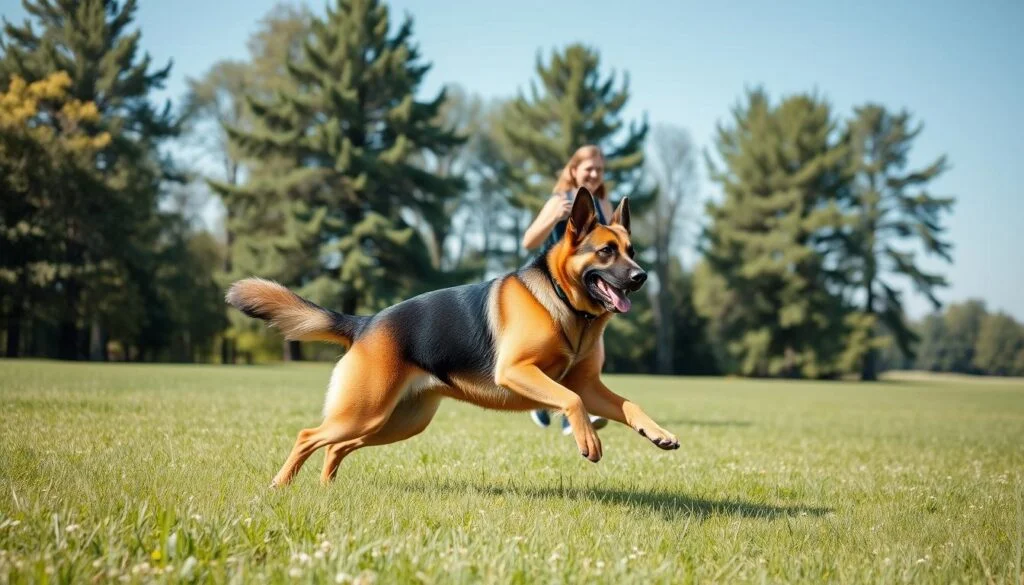
Rural vs. Urban Environments
Understanding the pros and cons of rural versus urban environments is essential for providing the best life for your German Shepherd. The environment significantly impacts their well-being and behavior.
Benefits of Country Living
Country living offers German Shepherds ample space to roam and exercise freely. The rural environment is conducive to their high energy levels and provides them with the physical activity they need. Key benefits include:
- More space for exercise and roaming
- Less noise pollution
- A more natural environment
Navigating City Life
Urban environments require careful consideration and training to ensure German Shepherds can thrive. City living demands:
- Exceptional leash training and impulse control
- Structured routines with dedicated exercise times
- Extensive socialization to city life
- Noise desensitization training
By understanding these needs, you can help your dog navigate the challenges of urban living.
German Shepherds and Allergies: Environmental Considerations
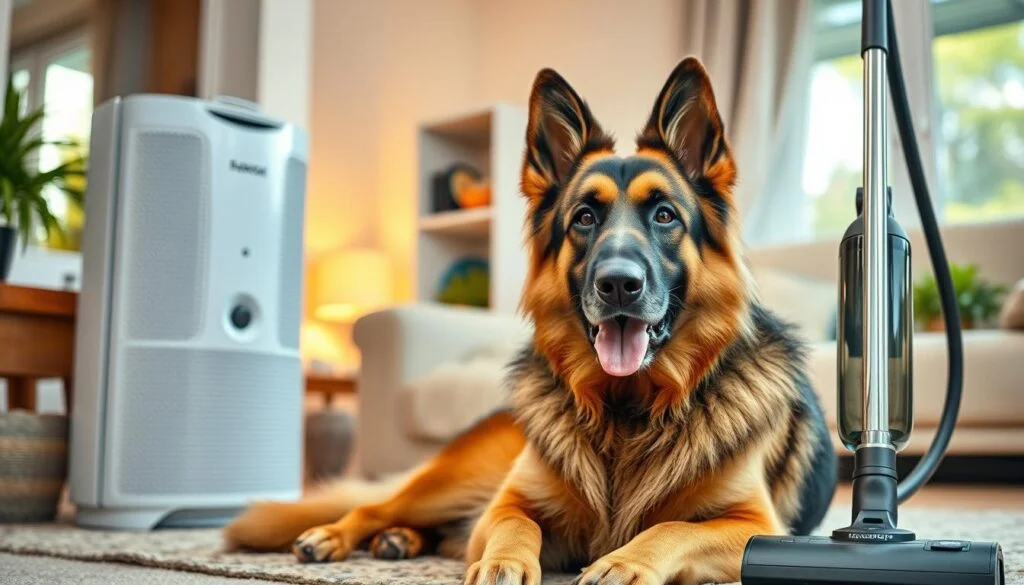
The question on many minds is: are German Shepherds hypoallergenic? Unfortunately, German Shepherds are not considered hypoallergenic due to their double coat, which sheds heavily. This shedding leads to an increase in dog hair and dander, common allergens that can exacerbate allergy symptoms.
Shedding and Dander Challenges
German Shepherds shed their coat heavily, releasing dander into the environment. This dander becomes airborne and can be inhaled, triggering allergic reactions in sensitive individuals. Regular grooming can help reduce the amount of loose hair and dander.
Managing Allergies in Your Home
To manage allergies with a German Shepherd, several steps can be taken. Investing in a robot vacuum can help keep floors clean daily, reducing dog hair and dander. Keeping your dog off furniture and out of bedrooms can also minimize exposure to allergens. Using an air purifier and covering air vents with cheesecloth in dog-free zones can further reduce allergen circulation. Additionally, bathing your dog weekly with a deshedding shampoo and brushing them daily can significantly reduce loose hair and dander.
Other strategies include creating allergen-free zones, using washable slipcovers on furniture, and installing hard flooring instead of carpet. For those considering bringing a German Shepherd into their home despite allergy concerns, spending time with the breed beforehand is advisable to gauge your allergic reaction.
Creating an Enriching Indoor Environment
Creating an enriching indoor environment is crucial for the well-being of your German Shepherd. A stimulating space can help prevent boredom, stress, and destructive behavior.
Mental Stimulation Essentials
To keep your German Shepherd mentally stimulated, you need to provide a variety of activities and toys. This can include puzzle toys filled with treats, interactive games, and obedience training exercises. As noted by dog experts, “Mental stimulation is just as important as physical exercise for dogs like German Shepherds.”
- Rotate toys regularly to keep things interesting and prevent boredom.
- Engage your German Shepherd in interactive games like hide-and-seek and scent work.
- Provide problem-solving toys that challenge your dog and keep them engaged.
Safe Indoor Play Areas
Designating specific play zones in your home can help create a safe and enjoyable environment for your German Shepherd. Remove any fragile or hazardous items from these areas, and consider using rubber mats or carpet runners to prevent slipping.
- Use durable toys that can withstand your dog’s enthusiastic play.
- Create a safe and comfortable play area by removing any potential hazards.
- Supervise playtime to ensure your dog’s safety and prevent accidents.
Training Environments for Success
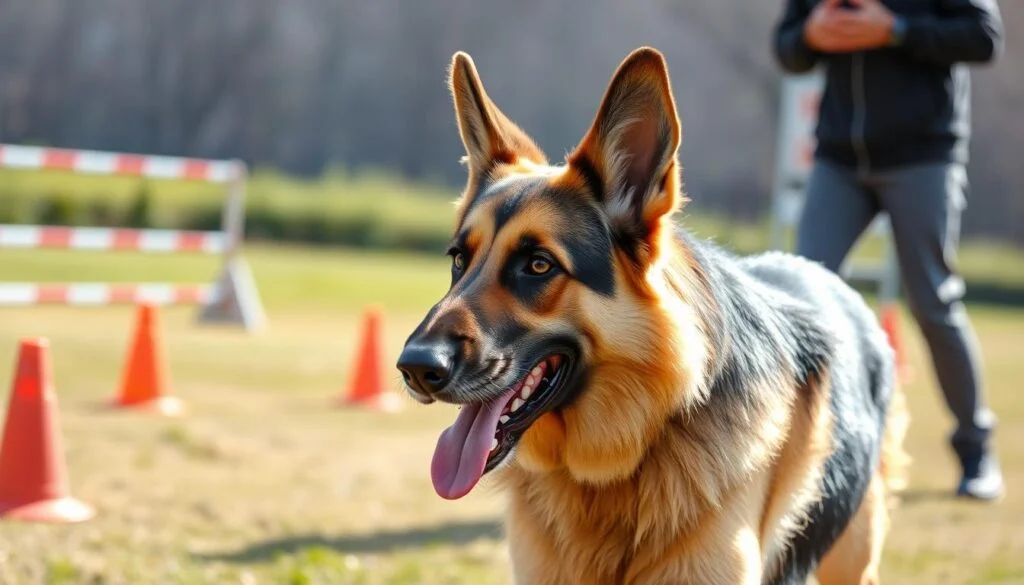
Your German Shepherd’s training environment plays a vital role in their overall development and behavior. A well-structured training space is essential for effective learning and obedience.
Structured Training Spaces
Structured training spaces are crucial for teaching your German Shepherd new commands and behaviors. These environments help minimize distractions, allowing your dog to focus on the training.
- Exposing German Shepherds to diverse environments during their critical socialization period (8-16 weeks) helps develop confident, well-adjusted adult dogs.
- Controlled socialization environments like puppy classes provide structured interaction with other dogs under professional guidance.
Socialization Environments
Socialization environments are vital for your German Shepherd’s emotional and psychological development. Positive experiences in these environments prevent fear-based reactions and potential aggression later in life.
- Creating positive experiences with various people, animals, sounds, and surfaces prevents fear-based reactions and potential aggression later in life.
- Using positive reinforcement during socialization experiences helps your German Shepherd form positive associations with new situations and stimuli.
- Gradually increasing environmental challenges as your German Shepherd matures builds confidence and adaptability in different settings.
Health-Related Environmental Considerations
A well-designed environment is essential for supporting the health and mobility of German Shepherds. This breed is prone to specific health issues that can be mitigated by environmental adjustments.
Joint Health and Appropriate Flooring
German Shepherds are susceptible to joint issues such as hip and elbow dysplasia, which can cause pain and difficulty walking. To alleviate this, it’s crucial to have appropriate flooring that reduces strain on their joints. Avoiding slippery surfaces and using mats or rugs can help prevent accidents and provide comfort.
Temperature Control for Comfort
German Shepherds have a double coat, requiring careful temperature control to prevent overheating. Providing cooling options like elevated beds, cooling mats, and shade is vital. Indoor temperatures should be maintained between 65-75°F (18-24°C) to accommodate their thick coat. Using fans or air conditioning can help regulate their body temperature, and monitoring for signs of overheating is crucial.
Conclusion: Creating the Optimal Environment for Your German Shepherd
The key to a happy and healthy German Shepherd lies in understanding their specific needs and adapting your living situation accordingly. Creating the optimal environment makes all the difference in their health, behavior, and quality of life over their 9-13 years with you.
To achieve this, it’s crucial to provide adequate space, regular exercise opportunities, mental stimulation, and appropriate social interaction. Whether you live in a suburban home, rural property, or urban apartment, your commitment to meeting your German Shepherd’s needs is paramount. No single environment is perfect for every German Shepherd dog; the key is adapting your living situation to fit your individual dog’s temperament and needs.
By doing so, you’ll create an environment where your German Shepherd will thrive as a well-adjusted, happy companion. Your effort will shape their behavior, health, and happiness throughout your years together, making the difference in their life.

